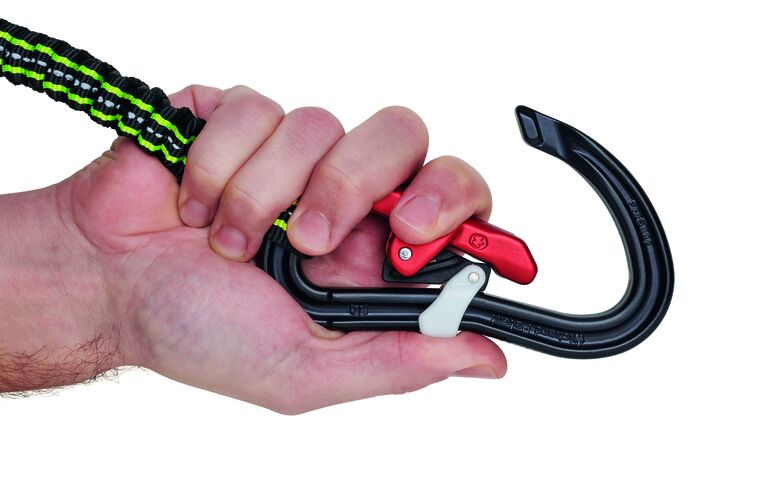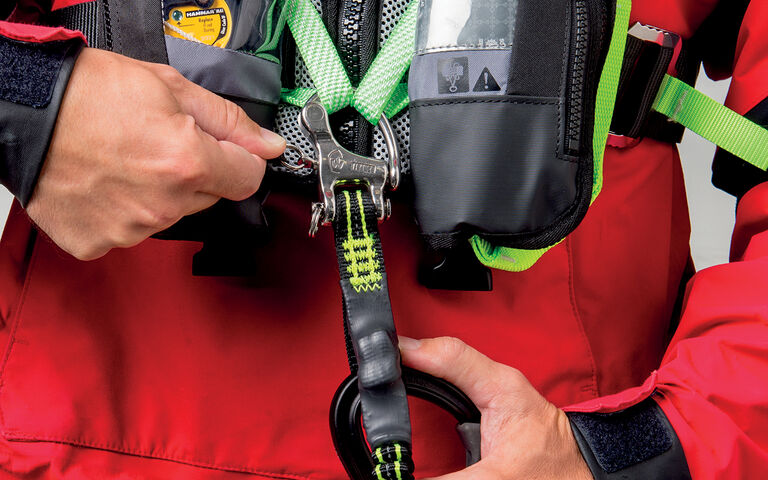Harness tethers are an essential piece of safety equipment, commonly used for both offshore ocean racing and coastal recreational sailing. In this article, we present Wichard’s new Proline tether, the most advanced tether in our offering.
The Harness Tether: An Essential Safety Equipment at Sea
Critical equipment on any boat, harness tethers connect you to your vessel via a jackline or an anchor point. The harness, tether, and jackline are invaluable to sailors when it comes to moving safely on deck, regardless of conditions. If you were to be thrown overboard, the tether's role is to keep you connected to your sailboat.
For sailing beyond 6 nautical miles from shelter, the harness tether is part of the mandatory safety equipment to have on board. In France, Division 240 stipulates that recreational boaters on non-sailing vessels must have at least one harness and tether on board, while those on sailboats must have a harness and tether available for each person on board.
We recommend having this equipment regardless of the intended navigation zone. By assigning a specific harness and lifeline to each person on board, you ensure the entire crew's safety!
Proline Harness Tethers: Wichard's Most Advanced Tethers
Wichard’s first harness tethers were introduced in 1994, and have since undergone constant reform and improvements to arrive at the latest iteration of Proline tethers. All components have been enhanced over the years: utilizing modern materials, technical innovations, and adapting to the everchanging needs of performance sailors. This has resulted in the exceptional new generation of tethers: the Proline equipment.
Proline Harness Tethers in Detail
For over 30 years, our goals have remained the same: to guarantee our clients the safest and most comfortable experience possible during their on-water activities. Each element of the Proline tether is designed with these goals in mind.
The Snap Hook
Since 1994, Wichard has consistently improved the snap hooks used on tethers. In 1998, the brand won the prestigious DAME Award at the Marine Equipment Trade Show (METS) with its double-safety snap hook.
In 2013, Wichard continued to innovate by launching the first harness tether with an aluminum snap hook. This new lightweight component improved user safety and usability, reinforcing our positioning as a market leader in safety products.
Since then, all Wichard carabiners feature the patented V-nose feature, which eliminates the notch at the snap hook gate, allowing sailors to detach easily from the tether without the snap hook catching on the strap. As the saying goes, "one hand for the sailor, one hand for the ship". Thanks to this new design, sailors can now operate with one hand, using the other for safety.
The snap hooks included with new Proline tethers bring their own innovations as well, featuring a larger 26mm opening to enhance the product’s convenience and ease of use. Good news: sailors wearing gloves will no longer have difficulties operating their snap hooks!

The Locking Mechanism
Reliable and safe, the Proline tether's locking mechanism prevents any risk of accidental opening, regardless of the attachment choice. The difference lies in the two-step movement, requiring an action on the lever and an action on the latch. The mechanism is ergonomic and easy for everyone to use: men, women, and children.
The Webbing
On Proline tethers, the webbing has the correct length and elasticity to allow sailors to move safely and perform maneuvers without detaching. When the webbing is not under tension, the compact design allows the sailor to move without hindrance and with minimal risk of tripping over it. The overload indicator on the equipment ensures that there hasn't been a significant impact and that it remains safe for use.
A retroreflective thread in the middle makes the webbing visible at night by reflecting light back towards its source. This might seem trivial, but it can be crucial, especially in an emergency. A sailor in danger can be spotted immediately by rescuers!
Finally, the updated Smart Loop feature of the Proline tether transforms a two-snap hook tether into a three-snap hook tether. A three-snap hook setup provides the ability to clip into a new attachment point or jackline before unclipping from your existing attachment point.

Two Ranges: Proline and Proline'R Harness Tethers
Among the safety equipment offered by Wichard, the Proline tethers are available in two distinct ranges: the Proline range and the Proline'R range.
Proline Harness Tethers
The first range consists of four distinct products: references 7036, 7037, 7038 and 7039. Products in this range include a flat or elastic webbing tether with a length ranging from 0.80 - 2 meters, equipped with one, two, or three snap hooks. Every variation features snap hooks with double safety mechanisms.
Proline'R Harness Tethers
The Proline’R range consists of two releasable harness tethers: references 7066 and 7069. Both products feature an extendable tether up to two meters long and can be fitted with two or three carabiners. In the first case, the 7066 includes a double safety carabiner and a stainless steel releasable snap hook. In the second case, the 7069 includes an additional double safety snap hook.
Manufacturing Our Harness Tethers
Rigorous and Specialized Production of Safety Equipment
Wichard safety equipment is more than 90% manufactured in France. As part of our CSR approach, we use materials sourced nationally and within Europe. We are, of course, mindful of limiting the carbon footprint associated with our production.
Plastic parts are manufactured near our Thiers factory. The webbing is produced by a French subcontractor. The snap hook manufacturing is also local, with all forging, cutting, machining, and even assembly operations carried out in our own facilities! The latch, forged in Europe, is the only component made abroad.
Reliable and Safe Harness Tethers with Verified Quality
As with all other elements offered by Wichard, each individual tether is systematically inspected.
Three tests are conducted at our facility to verify the reliability of a tether:
-
The drop test, where the tether is attached at a height of two meters and weighted with a 100 kg mass. When dropped, the product's integrity and the carabiner's opening are checked.
- The salt spray test, which checks the material's corrosion resistance. The study is conducted in a saline environment for 160 hours.
- The tensile test bench, which verifies the carabiner's strength under loads imposed by the standard.
After these significant checks, each Wichard tether is declared compliant.
An Essential for Our Equipment: Adherence to Safety Standards
At Wichard, we place great importance on adhering to various safety standards. All models in the Proline range comply with ISO 12401: 2009. The Proline'R range products are CE marked. Further, all models in both ranges feature an overload indicator that meets the requirements imposed by World Sailing, the global governing body for all sailing competitions
Caring for Your Harness Tether
The care and maintenance of a tether is easy: simply rinse your tether with soapy water and then fresh water after each use, then dry it in a well-ventilated place. Ideally, you should store your equipment away from UV rays and avoid placing heavy loads on top of it.
We recommend that you check the condition of your equipment before each use. Inspect the webbing and stitches, watch for cuts, tears, wear, and identify any damage that could be caused by use or storage. If there is a tear in the webbing, your equipment is no longer compliant. Seek advice from one of our dealers.
The snap hook parts should also show no signs of cracking, deformation, or corrosion. Check the mechanism and ensure the carabiner operates freely: it should close and lock automatically when you release the latch after opening.
Do you have questions about our Proline harness lifelines or need help making your choice? Contact our team and let us assist you with your project.

